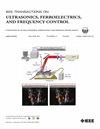床边超声矢量多普勒成像系统与GPU处理和深度学习。
IF 3.7
2区 工程技术
Q1 ACOUSTICS
IEEE transactions on ultrasonics, ferroelectrics, and frequency control
Pub Date : 2025-06-24
DOI:10.1109/TUFFC.2025.3582773
引用次数: 0
摘要
最近在矢量流成像方面的创新有望使这种模式更接近临床应用,并允许更全面的高帧率血管评估。其中一项创新是平面波多角度矢量多普勒技术,该技术利用多个转向角度的脉冲多普勒原理,以每秒1000帧(fps)以上的帧率实现矢量流成像。目前,矢量多普勒受到混叠伪影的限制,妨碍了其在床边的可靠实现。在这项工作中,我们提出了一种新的抗混叠矢量多普勒成像系统,该系统可以使用可编程超声核心、图形处理单元(GPU)处理和深度学习原理部署在床边。该框架支持两种操作模式:1)以17 fps的速度实时成像,其中矢量流成像用于引导动态复杂的血管图像视图导航;2)按需回放模式,其中以超过1,000 FPS的高帧率获取的流数据被描述为使用抗混叠矢量弹丸可视化的60 FPS的慢动作回放。利用该系统,成功地在狭窄模拟实验和人体分岔成像扫描中获得了无混叠矢量流线。该系统代表了矢量流成像在临床应用方面的重大工程进展。本文章由计算机程序翻译,如有差异,请以英文原文为准。
Bedside Ultrasound Vector Doppler Imaging System With GPU Processing and Deep Learning
Recent innovations in vector flow imaging promise to bring the modality closer to clinical application and allow for more comprehensive, high frame-rate vascular assessments. One such innovation is plane-wave multi-angle vector Doppler, where pulsed Doppler principles from multiple steering angles are used to realize vector flow imaging at frame rates upward of 1000 frames per second (fps). Currently, vector Doppler is limited by the presence of aliasing artifacts that have prevented its reliable realization at the bedside. In this work, we present a new aliasing-resistant vector Doppler imaging system that can be deployed at the bedside using a programmable ultrasound core, graphics processing unit (GPU) processing, and deep-learning principles. The framework supports two operational modes: 1) live imaging at 17 fps, where vector flow imaging serves to guide image view navigation in blood vessels with complex dynamics, and 2) on-demand replay mode, where flow data acquired at high frame rates of over 1000 fps is depicted as a slow-motion playback at 60 fps using an aliasing-resistant vector projectile visualization. Using with our new system, aliasing-free vector flow cineloops were successfully obtained in a stenosis phantom experiment and in human bifurcation imaging scans. This system represents a major engineering advance toward the clinical adoption of vector flow imaging.
求助全文
通过发布文献求助,成功后即可免费获取论文全文。
去求助
来源期刊
CiteScore
7.70
自引率
16.70%
发文量
583
审稿时长
4.5 months
期刊介绍:
IEEE Transactions on Ultrasonics, Ferroelectrics and Frequency Control includes the theory, technology, materials, and applications relating to: (1) the generation, transmission, and detection of ultrasonic waves and related phenomena; (2) medical ultrasound, including hyperthermia, bioeffects, tissue characterization and imaging; (3) ferroelectric, piezoelectric, and piezomagnetic materials, including crystals, polycrystalline solids, films, polymers, and composites; (4) frequency control, timing and time distribution, including crystal oscillators and other means of classical frequency control, and atomic, molecular and laser frequency control standards. Areas of interest range from fundamental studies to the design and/or applications of devices and systems.

 求助内容:
求助内容: 应助结果提醒方式:
应助结果提醒方式:


